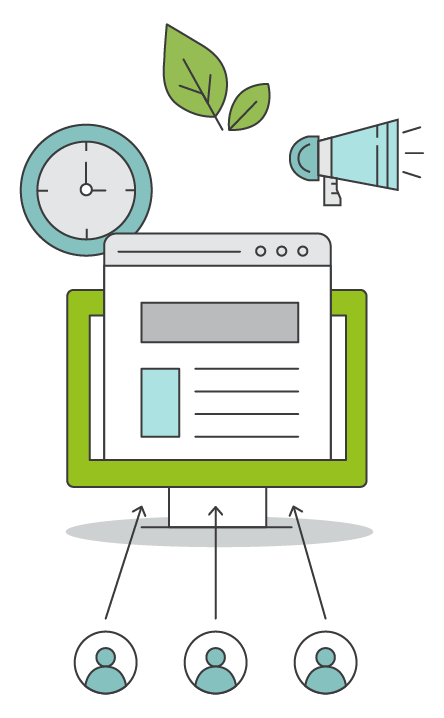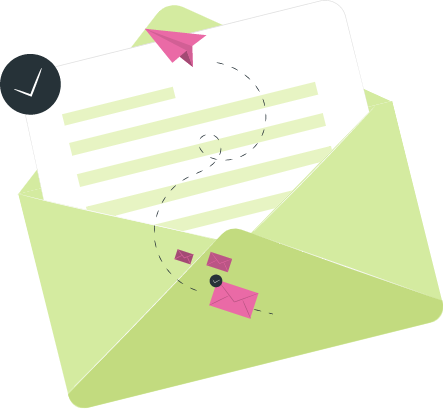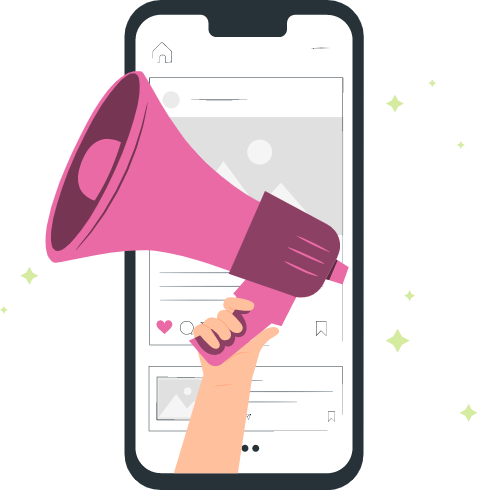Content Marketing, Explained
Use this guide to learn about what content marketing is, what its benefits are, how to use it and how to measure its effectiveness.
Brief History of Content Marketing
Content marketing has been around for centuries — it just didn’t have the same name.
Benjamin Franklin’s publication of Poor Richard’s Almanack in 1732 is commonly credited as being the first example of content marketing. Franklin created and promoted content that his audience wanted to read as a way to increase awareness of his local printing business.
Fast forward to the 20th century, and Michelin began publishing guides to Parisian attractions for an audience of 3,000 automobile owners — in 1900! Four years later, Jell-O created and distributed recipe pamphlets door to door to generate interest in just how versatile Jell-O mix was in the kitchen.
Pre-internet, Proctor and Gamble perfected branded radio by broadcasting soap operas with strategic product placements aimed at stay-at-home moms. In the ’50s, Kellogg’s tailored its graphic design and brand messaging toward children, allowing them to sell more cereal.
Today, big brands dominate the web, and social media platforms have supplanted traditional advertising methods. It’s virtually impossible to succeed as a B2C or B2B enterprise without leveraging content marketing in its modern form.

B2C Vs B2B Content Marketing
Conversely, B2B content marketers typically make greater use of LinkedIn, long-form collateral, account-based strategies and niche audience development. Sales cycles can take months or years, and customers may have million-dollar requests for proposals (RFPs).
Content marketing applications are industry-agnostic. Regardless of target market, geography, language or product, companies have to publicize their message and form a connection with customers.
In general, B2C is characterized by a heavier reliance on consumer-centric social media platforms, e-commerce websites, mobile-friendliness and shorter-form assets. Sales cycles are shorter, and user expectations are extremely high.
The Benefits of Content Marketing
There are nearly infinite benefits to employing a content marketing strategy.
Some of the most prominent content marketing benefits include:
Unifying the sales and marketing teams is a prized goal of every company, but one that’s rarely achieved. With content marketing, both departments’ efforts feed into the same funnel, making scalable alignment as easy as ever.
For example, the marketing team can leverage insights gleaned from sales calls and customer feedback, while the sales department can complement their prospecting efforts by distributing marketing collateral.
A clear way to look at the benefits of content marketing is to take a step back: What does your organization want to achieve? From there, you can tie your commercial objectives to specific content marketing goals and actions.
If your goal is improved lead quality, a targeted lead nurturing campaign would prove invaluable. Similarly, if your goal is thought leadership, investments in social media and organic content creation would be a worthwhile strategy.
Running content marketing campaigns empowers you to achieve any objective you need to, without wasting resources on short-term strategies or costly advertising.
How SEO Fits In
In a practical sense, search engine optimization (SEO) and content marketing are one and the same.
To rank highly in search engine results pages (SERPs), you need high-quality content that drives organic traffic. SEO is a foundational component of content marketing in that it is often the centerpiece of all strategies and campaigns. Optimizing your content allows you the opportunity to update your brand messaging for a modern audience, outrank competitors for high-value keywords and keep your web pages aligned with Google’s preferences.
To achieve your content marketing goals, SEO is often the best place to start.
Ranking Factors
Within the practice of SEO, there are specific ranking factors to consider. According to Google, there are more than 200 that its crawlers weigh when indexing your web pages. Based on how your site and your content fare in these assessments, an algorithm will serve your pages to searchers.
It’s important to note that some ranking signals are stronger than others, and Google doesn’t often reveal the exact weight of each one. However, we do know a handful of top considerations. To rank well on Google, you need:
- Internal and external links, used wisely.
- High-quality content that is authoritative and useful.
- An optimized page and user experience (UX), including for mobile.
- To act in a way that cultivates trust in users.
- Minimal distracting advertisements, such as intrusive pop-ups.
- Good page speed.
To summarize, every piece of content you publish on your website should be interesting, useful and trustworthy. As for the rest of your site, make sure it’s intuitive, user-friendly and has fast load times.
How Content Marketing Relates to Traditional Marketing
Traditional marketing refers to older, more conventional advertising tactics, such as:

Direct mail (brochures, flyers, coupons, cards, etc.).

Print advertising (magazines, trade publications, billboards, etc.).

Radio or TV commercials.

Telemarketing (cold calls, etc.).

Door-to-door sales.
These channels were perfected decades ago. And while they were put to good use in their heyday, they don’t effectively scale to today’s modern, digital audience. Their limitations often result in:

Disrupted user experience.

Short lifespan.

Cost-inefficiencies.

Low-quality leads.
A traditional outbound marketing strategy means businesses must constantly gain the attention of an audience by interrupting other forms of content. For instance, viewers tune into the radio for the music and the commentary — not the ads in between. And, readers buy magazines for thought leadership and research — not the every-other-page ads.
As you can see, traditional marketing can leave a bad taste in the mouth of consumers, especially in relation to today’s enterprise-level marketing campaigns.
But what about inbound marketing?
Inbound Marketing
Content marketing adheres to an inbound model. Instead of forcing your messaging onto leads, you organically pull them to your brand and message with content. In other words, inbound marketing helps put you in front of customers who are already searching for things that you offer and on their own time.
That said, there is still a place for traditional marketing tactics in modern business. For a more in-depth look at how inbound and outbound marketing can work together, and a brief history of their relationship, check out this infographic: The Difference Between Inbound and Outbound Marketing.
Find out more about this here.

How to Build a Content Marketing Strategy
Understanding Your Target Audience
One maxim of content marketing to keep in mind is: You are not your target audience.
Creating content because you “think it’s good” is not enough. In fact, it’s not even advisable. Instead, be 100% user-focused by creating content that answers their questions, piques their interest, and engages them.
In practice, this means creating dedicated personas. Anywhere from 3 to 5 is a good starting point. Creating these sketches outlines who you should be targeting, where they currently are in their journey and which types of content are most likely to resonate with them.
As a reference point, distinguish between a few different types of site visitors:

Top Engager
This is the person who not only clicks on your articles but also engages with them, uses them for research and may subscribe to several of your company’s marketing channels.

Top Influencer
This is the person who has only surface-level knowledge of who you are and what you do. They don’t have time to read every page of your site, and they prefer to stay out of the weeds day to day. Their role is a facilitator of vendor information. They share your content with internal stakeholders, vouch for your services over competitors’ and want to speak with you directly – before looping in their boss.

Top Decision-maker
This is the person who signs on the dotted line, and has the authority to do so. They won’t engage or interact with your site really at all – they just need enough information to make a good decision on a potential business relationship. This person has quotas to hit, hard deadlines to meet and wants to get down to business rather quickly.
Each of these personas has different motivations and interests, both personally and professionally. As such, they interpret and experience your site in unique ways. Targeting your content to each persona and adjusting your KPIs accordingly can help keep your metrics accurate and actionable.
As you can see, at the marketing level, there is no single “target audience.” Once you look into the core details of why you’re creating content and for whom, you realize there are varying tiers and shades within your target audience.
Working on creating your target audience personas? Try starting with this template.
Deciphering User Intent
Not every person who lands on your website is looking to interact with your brand in the same way. In fact, there’s an endless number of permutations: some want to browse, others to buy — and some do a number of other things that fall in between.
For the purposes of constructing your sales funnel and targeting the right audience, it’s important to distinguish between the 3 types of searcher intent:

Informational
Users who search with informational intent purely want information, and it’s not always clear why they arrived on your site. They might read one blog post, then never return. They might browse your home page, then a product page. But for the most part, they’re just gathering information and learning as much as they can along their search journey.

Navigational
Users who intend to navigate to a specific page of your site, or to gather a specificc piece of information, are considered navigational. In other words, the first page they click on may not be the true destination they seek — they still need to be directed to secondary pages or conduct another search query.

Transactional
Users with transactional intent are looking to purchase something — or, at minimum, do some comparison shopping to see how your prices and services stack up against similar providers. These searchers are more likely to visit product pages, add items to online shopping carts or ask for sales quotes.
Each of these 3 types of searches carries tremendous value, as they’re effectively data goldmines.
By understanding how searchers query, and the intent behind those queries, you can build strategies that directly address their intentions.
For example, the following 3 queries revolve around a similar topic, but you can clearly identify the difference:
- Brafton inbound marketing (informational).
- Brafton Linkedin (navigational).
- Brafton white paper pricing (transactional).
With this knowledge, you’re able to create content around those specific keywords and keyphrases with a higher likelihood that it’s reaching the right audience at the right time.
User Experience and Customer Service
Some refer to UX as the Amazon Effect or even the Google Effect: Once consumers have their expectations for speed, service and quality met in one area of their life, they expect that same level of positive experience in all facets of their life.
What this means for content marketers is that the content they create must be incredibly practical and useful to readers. It can’t be fluffy. The same goes for the overall design of a website and the total customer experience.
Making your content and your site UX-friendly means ensuring it’s optimized for mobile devices, contains visual elements, is authoritative and entertaining, loads quickly and provides them with helpful takeaways. In other words, make your content memorable and frictionless.
Because there are no second chances for first impressions, every touchpoint and experience matters. UX could be the difference between a new customer and a churned customer.
The proliferation of social media and online review platforms makes it extremely easy for satisfied or disaffected customers to preach your strengths or decry your weaknesses in public forums. This means there are real commercial risks involved with having a poor user experience.
Content marketing is a constant pursuit toward UX perfection across every channel and web page.
How To Create a Content Marketing Strategy
No two content marketing strategies are the same — at least, they shouldn’t be. At a high level, “blogging” is a strategy, as is “video marketing.” But digging deeper into the tactics, timelines and targets of those strategies reveals that there is a lot of variability and subtleties at play.
To develop a content marketing strategy that’s uniquely designed for your brand and your goals, consider these starting points:

Identify short- and long-term business goals.
For example, a 40% increase in customer subscriptions in the next quarter.

Establish how the marketing team can help deliver on those goals.
Create middle-of-the-funnel content that helps push prospects closer to a conversion.

Understand which buyer personas you’re targeting with your content.
Who within your target audience has purchasing power to become a paying customer?

Decide which types of content are preferred by those buyers.
Does this persona mostly consume short articles or do they prefer video demos and face-to-face meetings?

Select promotions and distribution channels your target audience already uses.
Are they active on specific social media platforms or are they relying on email or search engines to gather information?

Map conversion pathways to the customer journey.
At which stage of the funnel are you hoping to increase conversions and remove any final customer obstacles?

Design calls-to-action and event triggers for tracking and measuring performance and goal completions.
To properly attribute success and identify dropoff, create clickable CTAs that lead to dedicated landing pages. Then, track those clicks and actions on an analytics dashboard.

Create a template, model or workflow that organizes and facilitates the execution of the above steps.
Use agile methodology, project management software, creative agency vendors or other “systems” to coordinate your campaign.
Converting with CTAs
Any marketing campaign is only as successful as the conversions it generates. Calls-to-action (CTAs) provide users with a way to interact with your brand, whether that’s downloading a white paper, signing up for a webinar or requesting a sales demo.
A CTA gives next steps so users can navigate to additional pages throughout your site or reach out to you directly. They’re basically shortcuts for users to become paying customers.
CTAs should exist on every page of your site, and they can be embedded anywhere throughout your content — not just at the very end. The most important thing to keep in mind with CTAs, though, is that your direction needs to be clear and consistent. What actions do you want users to take?
By attaching metrics to each CTA, you can track their performance and optimize them to convert even more users in the future. For instance, you may want to track both micro and macro conversions:
Micro
- Newsletter subscriptions.
- Gated asset downloads.
- Navigating to a contact page.
Macro
- Quote request.
- Adding items to an online shopping cart.
- Reaching out to a sales rep.
To optimize CTAs, you might adjust details like:
- Design, including color, typography and size.
- Placement on the page.
- Target link.
- Phrasing.
Content Marketing Distribution Strategy
How you distribute, promote and amplify your content has a direct impact on how your messaging is received and how far it reaches.
Simply having the right distribution channels in place isn’t necessarily enough to make your content achieve its full potential. You also need to optimize those specific channels to ensure maximum impact. For instance, if you want to increase your email marketing conversions but don’t have email lists segmented effectively, you could be targeting too many people at once without any conversions to show for it.
Based on industry studies and experiments we’ve run internally over the years, we’ve discovered that there are 10 important distribution strategies to implement before launching your content.
The top 10 marketing distribution strategies are:
1. Determine distribution channels at the same time you brainstorm content ideas.
This makes every asset completely aligned and on brief with what you hope to achieve.
2. Fix all indexing issues and mark up your site with proper schema.
Organic search as a distribution channel only works if search crawlers can accurately interpret your site and serve it to users in SERPs.
3. Segment your email lists and set up custom marketing triggers.
Email marketing can get very complex very fast, but it’s the perfect channel to control nearly every aspect of what happens. Be as detailed as possible and track every event, trigger or action. Then, feed that data back into your next email campaign.
4. Solicit micro influencer contributions.
Authorities in your space who share your content are your marketing allies, and they can signal boost your content to heights you could have never achieved alone. Ask them to contribute a quote to your next article, appear on your podcast or collaborate on joint ventures.
5. Measure paid distribution.
Pay-per-click advertising through search engines and social media platforms can be costly without appropriate oversight and targeting. When done right, however, you can reach more users quicker than if relying solely on organic marketing. Be tactical with your investments and use paid media distribution as a smaller percentage of your budget.
6. Podcasting.
The number of people consuming audio content has grown tenfold in recent years, and those who listen to podcasts weekly do so for more than 6 hours per week. This is a huge audience you cannot ignore.
7. Use browser notifications where applicable.
You can send targeted messages to users on your site with the click of a button, and if they hit accept you’ve immediately added another person to your email list. Browser notifications only take minutes to design and you can generate a lot of activity quickly. Just beware of the click quality you receive.
8. Maximize email signature real estate.
If you’re already sending out emails, why not make your email signature more actionable? Include contact info, clickable CTAs, product catalogs, links to recent content, etc.
9. Guest blogging for backlinks.
With quality backlinks being a top Google ranking factor, posting on credible, high domain authority (DA) sites can send additional referral traffic your way and, over time, boost your own site’s DA.
10. Webinar marketing.
Virtually any type of content can be converted into a webinar. The narrated, slideshow, Q&A format increases viewer engagement, generates leads via registrations and makes your content multifunctional.
Content Marketing In the Sales Funnel
The sales funnel is the elemental foundation of marketing and sales alignment. For any business, knowing how your funnel takes shape, how each stage performs and where improvements can be made empowers you to create content that’s more likely to resonate – and convert.
Using a common understanding of the sales funnel, we can divide it into 4 constituent parts:
Awareness
Users are just discovering your brand and are not looking to be persuaded or sold to.
Interest
Users may be intrigued by your offerings and interested in seeing more content or following your brand on social media.
Consideration
Users are more intent-driven and are actively comparing your brand against others based on whether your products or services align with their distinct needs.
Purchase
Users are ready to become paying customers after they’ve fully vetted your brand. All that awaits is a swipe of a card or a contract signature.

User intent varies within these 4 phases. Whereas a traditional marketer would blast all 4 of these buyer personas with the same templated TV commercial, a content marketer would create more personalized messaging that targets users within the confines of their specific stage of the funnel.
This level of distinction and optimization means every piece of content is geared toward a specific audience, and that you can better track your investments within the funnel. Similarly, you might find that prospects make it to the consideration stage of the funnel and then drop out entirely. This signals a need to create content for the consideration stage that re-engages prospects, differentiates you from competitors and gives them a better reason to move to the purchase phase.
Here’s another look at the four sales stages and which types of content are best-suited to each:
Awareness
- Blog articles.
- Infographics.
- Social media posts.
- Podcasts.
- Short-form video.
Interest
- White papers.
- eBooks.
- Explainer videos.
- Conversion landing pages.
- Display ads.
Consideration
- Case studies.
- Customer testimonials.
- Web demos.
- FAQs.
- Sales sheets.
Purchase
- Sales emails.
- Testimonials.
As your team develops the above assets, you can deploy them with precision at their corresponding phase of the funnel. So you’re not mixing your messaging or confusing prospects with uncontextualized content, both your marketing and sales departments should work in complete cohesion, preferably with the support of sales enablement software.
Sales should not be cold-calling someone who is already at the purchase stage, and marketing should not be sending promotional emails to someone who clicked on your site for the first time yesterday.
As sales and marketing teams collaborate and work in unison, you have greater confidence that every asset is specifically engineered to convert users and that every decision is tied to measurable ROI.
Quantity vs Quality
Search engine algorithms are now better at identifying quality content than the engineers who wrote the algorithms, according to Google. As such, the quantity vs quality debate isn’t really a debate worth having.
The goal of every piece of content you create is to make a connection with a human reader, listener or viewer. Some enterprise companies who have the scale and reach to do so can post online several times a day. The average marketer, however, may create and publish content once or twice a week.
The biggest thing to remember about content marketing, though, is that volume is not a metric that search engines measure — and it may not even be one that consumers care about. On the other hand, marketers have traffic and conversion quotas to meet, and a higher volume of content can help hit those milestones. Balancing those internal data benchmarks with the actual value you’re providing to users is where your content marketing managers enter the equation.
They should have a discerning eye for what’s needed and what’s overkill.
Some of the best-ranking sites publish only once a month, if that. Yet they rank highly for every keyword they target.
Drawing that line can help marketers design more strategic campaigns and keep all stakeholders apprised of the underlying objectives they’re hoping to achieve.
What Does a Content Marketing Manager Do?
A content marketing manager is the quarterback of your content marketing investments. They devise the strategy, support its execution, facilitate the publication and distribution of assets, measure performance metrics and report on analytics.
They are uniquely positioned to make a large impact on the success of your efforts and are tasked with turning the marketing team into its own revenue center.
Learn more about this important role here: Everything you need to know about content marketing managers.
Building Content Marketing Workflows
Workflows standardize the processes you need to follow for any marketing activity you take on. Although every business operates in its own way, your marketing programs should stick to dedicated protocols due to the number of steps and stakeholders involved. Companies working with vendors, contractors, freelancers, temporary staff or other types of external parties will especially benefit from organized workflows and milestones.
Generally, starting with your goals and working backward is a useful path to take. Here’s a sketch of what that might look like:
1.
Set objectives for a defined period of time.
6.
Identify internal or external resources capable of creating content under this strategy and timeframe.
2.
Determine which stage(s) of the funnel will produce agreed-upon goals.
7.
Measure baseline analytics before the campaign begins.
3.
Decide which distribution channels will best serve those stages.
8.
Track real-time performance metrics and benchmark them against your baseline and your end goal.
4.
Qualify which types of content will best serve the target audience in question.
9.
Make content, distribution or strategy adjustments as needed.
5.
Quantify how much content is needed.
10.
Finalize the campaign and report the end result.
At that point, you’ve identified the campaigns you want to run, the collateral needed for each campaign, the resources required to create the collateral, and the expected outcome by which you’ll measure your success. It’s useful to then divide up your content creation needs into types to create standard workflows for each one.
On an asset-by-asset level, distinct workflows may vary. For example, a blog article takes fewer hands and less time than an on-location video shoot. That said, the content marketing manager will be the central vehicle driving deadlines, handoffs and quality.
Practitioners of agile methodology may adhere to a sprint-based workflow, working in short bursts to produce large batches of coordinated content. Other types of workflows may be more linear, with departments working one at a time like an assembly line — known as waterfall.
Depending on the scale of your campaigns and the resources you have in play, you may need dozens of marketing assets in the works at a single time, and multiple people managing the scheduling, collaboration and approval of each stage of those assets. Any micro-delay can lead to missed quotas.
To keep the full scope of your workflow on the rails, consider using:
- User-friendly video conferencing and communication tools.
- Collaborative file-sharing and file-editing.
- Clear metrics, benchmarks and milestones
A Content Marketing Platform can be the right solution for many brands engaged in content creation and marketing operations.
These software products include features such as:
- Chat and messaging capabilities.
- Content calendars to display when each item is released.
- Workflows to keep the whole team on schedule and in the know.
- Unique project spaces that house communications, deliverables and collateral.
- Integrations with other software such as Google Analytics and Semrush.
By bringing all facets of your content marketing strategy together into one cohesive hub allows marketers to complete tasks quicker, find assets easily, communicate efficiently with other stakeholders and generally just helps to make their job more organized. In fact, that’s the reason we built the Brafton Platform.
Download the latest Brafton product catalog.
How to Excel in Content Marketing
To really excel at content marketing, you need to plan, prep, measure, and pivot as necessary. Here are a few tips to help you go beyond the bare minimum and really shine:

Do your Research
SEO research informs your content to make it stronger. Before writing or producing an asset, make sure to do your due diligence in the research department.

Create Different types of Content
Some marketers may default to written content as their go-to type, but creating a buffet of content using different formats can help you diversify your brand and reach new audiences.

Create a Distinguished Brand Style and Stick to It
Consistency is key. Once you hone your brand voice and style, make sure you stick to it — or else you risk confusing potential customers and increasing churn.

Repurpose Old Content
Old content is not dead content. A tried and tested strategy of content marketing, repurposing old content not only breathes new life into assets that may have become dormant, but it also saves your business resources since the content already exists. All you have to do is turn it into something new.
Types of Content in Content Marketing
How to Generate Content Ideas
There’s no shortage of tools, tricks and tips for generating content ideas. If the primary roadblock to your marketing is volume, generating ideas in bulk could be worthwhile. Conversely, if your content continually misses the mark due to poor strategy, your goal may be to produce ideas that are more targeted and valuable to a smaller subset of high-conversion readers.
Here are some of the top places to find valuable content topics:
On-SERP Options
Google has a number of free, easy-to-use features directly in SERPs that can clue you into what you should write about.
- People also ask.
- Searches related to.
- Autosuggest.
- Trends.
- News.
SEO Tools
Diving deeper into keyword-driven ideas can help you understand search queries. Then, you can work backward to create content that backfills that search intent.
- Google Analytics.
- Semrush.
- Ahrefs.
- Answer the Public.
- MarketMuse.
- Moz.
Social Media
Following trending stories, viral events and high-engagement threads keeps you abreast of what’s happening in your industry and where you could possibly play a role in the conversation.
- BuzzSumo.
- Hashtags.
- Industry forums.
- Customer reviews.
In-House
Your company likely has plenty of unique industry and technical experience on staff — and they’re just a few desks over. Ask questions of different departments, brainstorm laterally with sales teams and learn more about the subject matter at hand by looking inward to those staff members.
- Collaborate with sales.
- Speak with product SMEs.
- Mine proprietary research.
- Distribute internal surveys.
Your organization should never be lacking content ideas. It’s mostly a matter of turning over enough stones within your company and via search engine tools that are free or inexpensive to use. Ensure the topics you generate, though, still align with your larger business objectives and that they can be refined in the content creation process to serve the ideal:
- Buyer persona.
- Stage in the sales funnel.
- Target keyword.
Content Marketing Channels
How you publish, promote and amplify your content is just as important as what you create.
While your marketing assets help define who you are as a brand and what message you want to convey, the channels in which you deliver those very assets will affect who sees your content and how well it performs.
There are numerous channels marketers can use to interact with prospects and customers. These are the 10 most important distribution methods you’ll likely come across:
1. Organic Traffic (SEO)
Generating organic traffic is achieved through SEO. In effect, site visitors click on your content they found organically in SERPs — and it all started with a search query.
The content you publish on your site is indexed by search engines and served to users, and it doesn’t have to just be blog articles. Video content and infographics — anything ungated, really – also appear in SERPs, granting you more exposure and the chance to funnel traffic to your site.


2. Paid Search Traffic (SEM)
Driving search engine traffic through organic content is a great long-term investment. But sometimes your company needs a faster, more measurable form of ROI, which can be accomplished via paid search ads.
As a form of pay-per-click advertising, paid search ads appear at the top (and sometimes the bottom) of SERPs, giving your brand major exposure that couldn’t be accomplished otherwise. Creating landing pages, branded ad copy and click-worthy titles on your paid ads can steal traffic from SERP competitors and funnel commercial leads to your site.
Related resource: How Does Pay-Per-Click Work? And Other PPC Questions, Answered.
3. Email Marketing
By distributing newsletters, gated assets and other forms of branded content directly to the inboxes of your email list, you can cut through the noise of the web and have one-on-one conversations with prospects and customers.
Segmenting your email lists into various account types, reader intent and industries can help you distribute content with precision and ensure your message gets to the right people at the right time.
Newsletters are a great place to start email marketing. Learn how to build an email newsletter from the ground up with our guide: How To Create an Email Newsletter That Converts.


4. Social Media Marketing
Social media helps give your marketing more personality, cause and commentary. You can post targeted content on one channel and other types of assets on another. Wherever your audience is, you meet them there.
Your social channels also empower you to respond to subscribers and followers, measure engagement in real time, promote products and network with influencers. It’s a versatile, highly vibrant ecosystem to capitalize on.
LinkedIn, YouTube, Facebook, Twitter, Instagram and Pinterest give your content reach it couldn’t achieve elsewhere, making it a vital tool in your distribution strategy. For example, earned media — or material that’s written about your brand that you haven’t paid for — is often easiest achieved on social platforms.
Here are more resources on how to use specific social media platforms:
- How To Post Your Content On Youtube and Engage Your Subscribers
- 5 Of The Best Types Of Content To Post On LinkedIn
- Understanding Facebook Sponsored Posts And How To Use Them For the Most ROI
- How To Grow Instagram Followers Organically (Infographic)
- When To Post on TikTok (& Other TikTok FAQs Answered)
- 13 Surprising Benefits of Snapchat for Marketing (B2B and B2C)
- Social Advertising Benchmarks
5. Link Building
Because quality, credible backlinks from authoritative sites are a Google ranking factor, obtaining them is an incredibly powerful way to increase your brand reach.
Link building is the methodology for generating interest in your content and securing the links you seek. You can do this through:
- Creating well-researched content that’s worthy of links.
- Publishing proprietary studies that don’t exist anywhere else on the web.
- Guest-posting on other high-value industry sites and publications.
- Manual link outreach.
Publishing your content, and then getting it in the right hands, is the key to link building. The link juice earned from each incoming domain URL will boost your site’s rankings.


6. Podcasting
As the average smartphone user spends nearly 4 hours a day inside apps, recording a podcast can put your company right in front of these users via Apple Podcasts, Spotify, iTunes, Anchor and the dozens of other listening apps on the market.
Podcasting gives your brand another forum to dive more deeply into niche subject matter, interview industry experts and network with like-minded companies and consumers. It’s a great way to deliver your message audibly, as listeners can enjoy your content while driving, riding the train, working out, cooking dinner and whenever they have downtime.
People will likely find your podcast in the same way they find your site: organically. Which means there’s a strategy to make your show discoverable to the average listener.
Learn more about how it works here: How do iTunes Podcast Rankings Work, Really? (Infographic).
7. Display Advertising
Staying in front of your audience as they move across the web is a great way to own mindshare and stay visible among so many competing distractions. Every time someone visits your site, a small piece of code is attached to them, called a cookie. After they leave your site, your paid ads may be displayed across other websites, apps or social platforms they visit, creating a trail of brand interactions. These ads are usually display banners composed of text, imagery and buttons.
Related resources:


8. Syndication
Content syndication is a network of websites that re-publish or re-feature existing content on the web, either in full or in short synopses. Syndication allows your content to achieve greater reach and appear in front of more online readers than it otherwise could on its own. The tradeoff, however, is that most syndication platforms are paid services and the quality of newfound traffic to your content cannot be guaranteed.
9. Event-Based Marketing
For industries that still do a lot of business offline, trade shows, conferences, forums and other community events are integral to marketing success. Blurring the lines between physical and digital marketing, event-based marketing relies on the power of both.
This might include speaking opportunities, webinars, lunch-n-learns or pop-up booths set up in public spaces with lots of foot traffic. For these events, you’ll need marketing collateral — like panoramic visuals behind you or even printed infographics on hand — and a promotions strategy to get your voice heard above the crowd. Other content distribution formats to consider within the context of events are augmented or virtual reality experiences, branded swag and interactive contests or giveaways.
Need some tips on promoting an event? Here are a few:


10. Mobile Marketing
Though mobile marketing is really a device preference that cross-cuts all the above channels, consumer behavior trends dictate companies should think of smartphones and tablets as distinctly valuable in and of themselves.
Marketing your content on mobile means, first and foremost, a fully mobile-responsive website design. It also entails optimizing your future content decisions to account for less text, more visuals and lots of clickable buttons — all seamlessly integrated directly into your web pages, emails and social feeds.
Mobile traffic also comprises the thousands of apps available to consumers — all micro channels through which you can promote your business, like podcasts, news aggregators and even standalone branded apps.
Types of Content
Content marketing formats can change often based on customer expectations and user demands. As websites and social feeds become more responsive and sophisticated, they’re able to host more dynamic file formats, granting marketers greater opportunities to reinvent the wheel.
Broadly speaking, content fits into 5 buckets:
Written:
- Blog articles.
- Product descriptions.
- Landing pages.
- Press releases.
- Long-form guides.
- FAQs.
- Email copy.
- Ad copy.
- eBooks.
- White papers.
- Gated assets.
- Case studies.
Video:
- Video blogs.
- Studio production.
- On-location video.
- Vox pops.
- Video interviews or testimonials.
- Animations.
- Web demos.
- Product demos.
- Corporate promos.
- Event footage.
- GIFs.
- Virtual reality and augmented reality.
Graphics:
- Infographics.
- Custom illustrations.
- Calls-to-action.
- Content formatting.
- Wireframes and site mockups.
Social:
- User-generated content.
- Hashtag campaigns.
- Complementary social posts.
- Quizzes.
- Polls/surveys.
- Contests.
AUDIO:
- Podcasts.
- Webinars.
- Recorded interviews.
Many types of content require collaboration with other formats, making them hybrid assets involving multiple stakeholders or departments. White papers, for instance, merge written copy and graphic design. And web demos involve written scripts, narration and animated designs to form a complete product.
General Content Marketing Best Practices
Although marketing standards and industry practices can change year to year, there are certain ideas that just make sense. And they’re widely applicable to every industry, budget and objective.
We’ve documented 50 of them in this eBook, but here are some of our favorites:
Break up your copy into shorter chunks for greater readability and mobile experience.
When unsure how to convey a complex idea succinctly, use visuals. Don’t try to write your way into mastery of a subject. Your buyer persona may prefer a 90-second animation anyway.
Use long-tail keywords and semantically related keyphrases to create well-rounded, authoritative content.
Whitespace is more friendly than you think. On websites, apps, emails, infographics, etc., – don’t over-design or over-clutter.
Write for humans, not search engines. At the same time, make your site search-friendly so that humans can find your content.
Optimize for featured snippets wherever possible.
Do not ignore email marketing. It delivers the highest ROI of any marketing channel.
Be wary of campaigns that heavily rely on influencers.
Use paid and organic strategies in tandem – it doesn’t have to be one or the other.
Automate every single task you possibly can.
Be social and start conversations. Respond to posts that you’re tagged in and find new ways to get people talking about your brand on social media.
Content Marketing Examples That Work
Because content marketing can take so many forms and speak to so many audiences and buyer personas, there are endless possibilities for what a single piece of content might look like.
Here are 7 content marketing examples, spanning various formats and buyer stages you might consider when building out your campaigns:
1. Blog Posts
Blog posts are a healthy base for your content marketing efforts. This is your platform to discuss popular industry subjects, position yourself as a thought leader, explain how your products can address common challenges and draw potential customers to your website.
Looking for advice on getting your blog started? This post has all the information you need: What Is a Blog? The Complete Guide To Achieving Real Results With Blogging.
Once you have blog content, you can repurpose it to create social media posts, long-form content on the same topic, eBooks using the same text but adding visuals and more. Here are some pointers on creating a content repurposing workflow.
2. Case Studies
Case studies describe a real issue that a real customer had and how your product or service helped them overcome that challenge. It’s bottom-of-funnel content that can be a huge help in converting customers. Hearing a true story about a satisfied customer’s experience is incredibly convincing.
Take this one, for example: Dozens of Page 1 Rankings for Gerard Malouf and Partners. The best case studies have a clear direction, including a brief backstory, challenges, solutions and results with string metrics laced throughout.
Find more examples here: 7 B2B and B2C Case Study Examples to Model Your Content After.
3. Infographics
People love infographics: They’re fun to look at, easy to understand and packed with information. For all of these reasons, including infographics in your content strategy is a smart idea. The best part: You have lots of leeway on how you want to design your infographic.
This eBook has a lot of inspiration for designing engaging infographics.
4. Explainer Videos
Explainer videos complement your other marketing efforts by explaining the benefits of a particular solution, details about a product or the nuances of a difficult problem.
Here’s an explainer video example from Freighty. The video starts by highlighting the goals of e-commerce businesses before diving into common challenges that may hinder an organization’s progress towards them. Then, it explains their service and how it can help businesses increase conversions. It’s short, sweet, and straightforward.
Learn more about incorporating video into your marketing strategy:
5. Testimonials
Testimonials can give potential customers an inside look into what it’s like to work with a company or use a particular product or service. Consumers trust them because they represent the voice of real consumers rather than the brand’s marketing voice.
The good thing about testimonials is that they’re so versatile. You can add written quotes to your website, email copy and other marketing materials. Or, you can create video or audio testimonials to use in other forms of media.
One brand that has embraced the testimonial is Chick-Fil-A, which features real customers in their radio and TV commercials. The result is a collection of testimonials that exude authenticity while reflecting the fast food chain’s brand values.
How should brands get started with creating testimonials? We have all the answers here:
6. Webinars
Webinars are online seminars that you can create and host for your audience. They can be live or recorded (or both), and they’re your opportunity to share your perspective on an industry theme, a product of your own or something else altogether.
Collaborative webinars are a great way to team up with another brand. For example, many of the webinars hosted by Content Marketing Institute are often done in collaboration with other brands. This brings in multiple sources of expertise to make each webinar more valuable and also draws in viewers from each brand’s audience.
Learn more about webinar marketing here — or check out Brafton’s webinars here.

7. User-Generated Content
User-generated content is exactly what it sounds like: content created by people outside your organization. This strategy engages real people, is unique and creative and very cost-effective.
Apple’s Shot on iPhone campaign is an example of UGC at its best, and they usually launch a new one whenever they have improved camera tech and features to show off. The company holds a contest wherein real people can submit photos and videos they took using their personal iPhones. Winners and runner-ups will be included in a number of ad campaigns.
Companies of all sizes can create a UGC campaign using social media to generate interest and share creations from followers and fans. Or, they can find UGC where they naturally occur, like blog comments and product reviews.
How to Measure Content Marketing Metrics
With marketing automation tools making data insights more accessible than ever, there’s an enormity of critical business intelligence to be discovered through content marketing.
Which metrics you choose to measure depends largely on the objectives you wish to achieve. Most practically, let’s delineate between vanity metrics and valuable metrics:
Valuable Metrics
To accurately report content marketing ROI, you must look at metrics that actually matter to your bottom line. These aren’t just marketing indicators; they’re integral commercial signals.
Metrics tied to revenue streams are inherently more important and more impactful when deciding where to place your resources and how to secure additional investments in the future.
Examples of valuable metrics include:
- Conversion rate.
- Customer acquisition cost.
- Customer lifetime value.
- Marketing-qualified leads.
- Sales-qualified leads.
- eBook downloads.
Vanity Metrics
Vanity metrics are data points that might disguise real, underlying trends or that aren’t totally tied to ROI in any meaningful way. You wouldn’t want to make business decisions based on vanity metrics because they predominantly show only consumption (buttons were clicked, pages were visited, etc.) but not cold, hard ROI. They don’t generate actual revenue and are really only useful in measuring non-transactional activity.
Examples of vanity metrics include:
- Pageviews.
- Bounce rate.
- Social media follower count.
- Site visitors.
- Keyword rankings.
Within these definitional boundaries, the act of tracking and measuring metrics can be as automated or manual as is preferable. Companies that lack the budget or talent may default to spreadsheets or simple Google Analytics dashboards, while more sophisticated marketers may use a series of integrated or parallel metrics engines.
Recommended analytics tools to kick-start your marketing measurement include:
- Google Analytics.
- Google Search Console.
- Semrush.
- Ahrefs.
- Moz.
- Salesforce.
- MarketMuse.
- Hotjar.
- MailChimp.
- BuzzSumo.
Set benchmarks before, during and after your marketing campaigns using the metrics that are most important to you. Be sure to implement proper tracking codes on all of your web pages, social feeds and email accounts, too, as this will be the mechanism for populating your analytics dashboards and ensuring your data is accurate and updated. In Google Analytics, setting up Goal Completions for Assisted Conversions is incredibly insightful as well.
When analyzing and reporting on your marketing metrics, avoid showing the obvious, surface-level indicators described above. Instead, frame the conversation around dollars in and dollars out, so that non-marketing stakeholders and executives can more easily follow along and appreciate the achievements your team has made.
So, rather than reporting on the number of leads generated last quarter, highlight the precise cost-per-lead. Similarly, instead of clicks, focus on click-through rate.
Content Marketing Tools
The market for content marketing tools (and its adjacent industries) grows every year. With user experience at a premium, and technology demanding marketers evolve their tactics in near real-time, software, plugins, dashboards, integrations and analytics are table stakes.
We’ve outlined below tech solutions to make your marketing more granular, more effective and more engaging:
SEO:
- Ahrefs.
- KeywordFinder.
- Semrush.
- Buzzstream.
- Majestic.
- Yoast.
- BrightLocal.
- WooRank.
Email Automation and Analytics:
- Marketo.
- Constant Contact.
- Pardot.
- Salesforce.
- MailChimp.
- HubSpot.
- Sendinblue.
Keyword Research:
- Semrush.
- MarketMuse.
- Moz Keyword Explorer.
- KeywordFinder.
- SpyFu.
- AnswerThePublic.
- Ubersuggest.
- Google Keyword Planner.
- Serpstat.
Social Media Automation and Analytics:
- BuzzSumo.
- Hootsuite.
- Buffer.
- SproutSocial.
Site Analytics:
- Google Analytics.
- Google Search Console.
- Optimizely.
- Crazy Egg.
Site Audit:
- ScreamingFrog.
- Raven Tools.
- Semrush.
- Google PageSpeed Insights.
Writing:
- MarketMuse.
- Hemingway App.
- Answer the Public.
- Grammarly.
How Long Does It Take for Content Marketing to Show ROI?
Return on investment can be tracked, analyzed and reported in a number of ways – and no two companies do it the same way.
After more than a decade delivering real results to our clients, we’ve found that a general rule of thumb to follow is: Content marketing takes about 6 months to begin showing true ROI.
As such, content marketing is a long-term investment — which is a good thing because, just like personal wealth, it compounds and builds over time. As long as your website and social feeds remain active, you have a comprehensive catalog of pages drawing traffic every single second. The better your content is, the more likely it is to generate higher ROI.
We’ve also discovered that it can take at least 100 days (or about 3 months) for your content to “fully mature” in the eyes of search engines. You can’t publish a blog post one day and expect immediate gains the next. Search engine algorithms must crawl your pages, parse through enormous amounts of code, assess the quality of your content and index those pages in SERPs for the appropriate searchers.
This process does not happen overnight. Google may rank your blog post in position 3 on day 10, but then position 12 a few weeks later – and vice versa. This volatility is Google’s way of finalizing just how valuable your web pages are to searchers and where in SERPs they should be featured.
After the 100-day mark, you can safely assume that those pages have “matured” and settled into a more concrete, predictable SERP position.
With this in mind, setting appropriate expectations within your company is key, as some stakeholders may demand quick wins or scientifically unrealistic goals. As your programs begin to show results, track their performance milestones and optimize subsequent content marketing investments accordingly. It may turn out you’re posting too many infographics and not enough videos, or you should focus on acquiring more backlinks and not more social likes.
Content Marketing Builds Bonds Between Companies and Their Audiences
So, now you know what content marketing is, plus how it works, why it matters, how to do it right and how to measure your successes.
Content marketing is actually an ancient practice that has found its home in modern business practices, and for good reason. The principles of content marketing are to help the customer first, build trust and authority second, and finally, when the moment is right for the customer, encourage them to convert.
By maintaining a foundation of helpfulness and honesty, you’ll build a brand customers trust, respect and care about. Now, it’s up to you to utilize content marketing for the benefit of your business.





